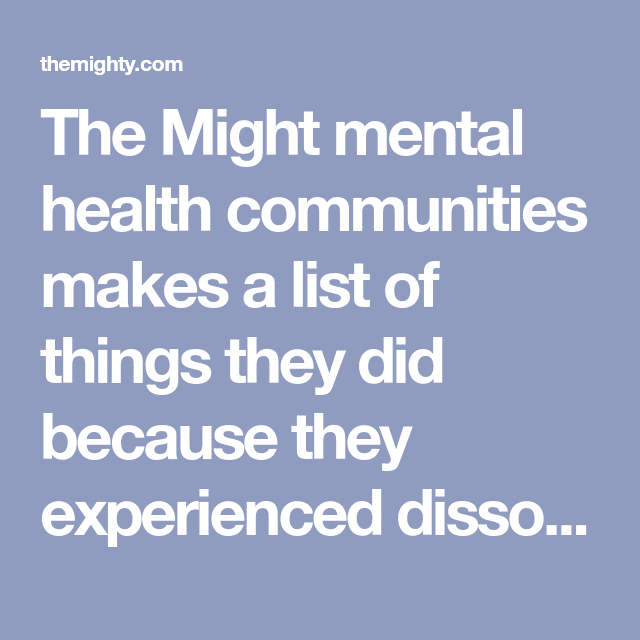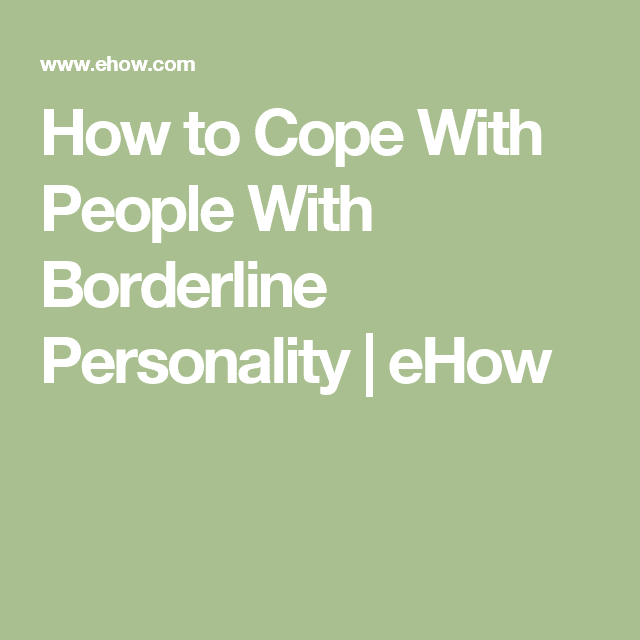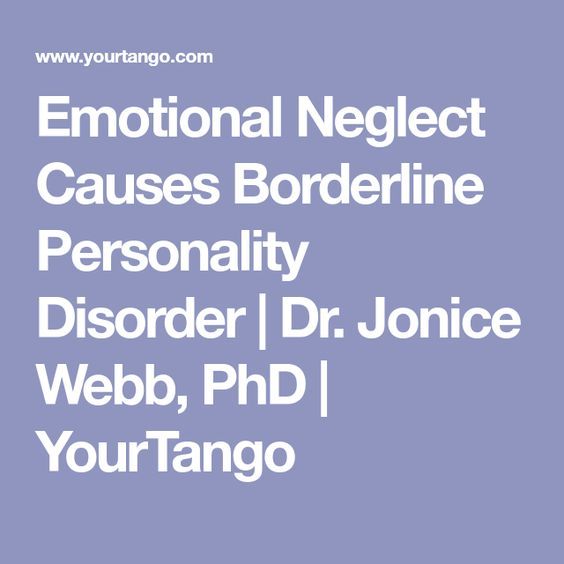Recognizing The Symptoms Of Bpd
People who have BPD often suffer, but so do the people around them. It is hard to be present-minded when one is barraged by another persons aggressive, impulsive, and/or chaotic behavior. It is easy to get hurt by someone who explodes in anger and contempt. Let us look at the symptoms of BPD before I make suggestions for how to respond to or become proactive with someone who is borderline.
Those with BPD have a pervasive pattern of instability in three main areas of life: interpersonal relationships, self-image, and affect. They act impulsively from a young age, even though we can only diagnose this disorder once the person is 18 years old. According to the DSM-52, the manual used to help diagnose psychiatric disorders, a person with BPD must meet at least five of the following criteria:
How To Learn Bpd Coping Skills
Ready to learn some new, healthier ways of coping? One way to do this is by seeking treatment. Many psychological treatments for BPD, including cognitive behavioral treatments such as dialectical behavior therapy , focus on teaching healthier coping skills to manage strong emotions.
There are online resource pages that can help you find a cognitive behavioral therapist or a DBT provider.
Treatment: Cbasp Inpatient Program
All participants underwent 10 weeks of multimodal CBASP treatment following the CBASP manual , modified for an inpatient setting . The CBASP program included two individual sessions per week , two group sessions per week , mindfulness training , group physical therapy and occupational therapy . In addition, patients had regular medical rounds by the attending physician as well as the senior physician and a weekly nurse-patient encounter . The whole team received regular CBASP trainings and supervision . One psychotherapist was a certified CBASP therapist , the rest of the team were at an advanced psychotherapy and CBASP training stage with weekly supervision.
Patients received algorithm-based psychopharmacological treatment following national guidelines for depression . Table 1 presents medication rates on admission and discharge.
Table 1. Frequency and percentage of prescribed drugs on admission and discharge and mean number of prescribed psychotropics for CBASP dropouts medication at the date of dropout is reported.
Furthermore, a specifically trained nurses’ team offered an optional weekly group skills training based on the Dialectical Behavioral Therapy manual by Bohus and Wolf-Arehult . The DBT skills training included sessions on mindfulness, distress tolerance, emotion regulation and interpersonal effectiveness. For each patient, the number of participated group sessions was assessed. Skills group dosage ranged from 0 to 10 sessions.
Also Check: Online Support Groups For Teenage Depression
Can Borderline Personality Disorder Be Prevented
Unfortunately, theres no way to prevent borderline personality disorder.
BPD is often inherited , which means you have an increased risk of developing the condition if you have a family history of BPD. Ask your healthcare provider how to recognize signs of the disorder so you can get treatment as early as possible.
Distinguishing Depressive Symptoms And Bpd

Depressive symptoms that occur in those with BPD are due to an identifiable stressor but depression remits when the stressor is removed or the relationship is restored. Depressive symptoms may be a means to communicate what is going on emotionally inside the client, such as anger, frustration, helplessness, disappointment, and so on.
Read Also: Too Much Rem Sleep Depression
Discovery Mood & Anxiety Program Can Help
Weve been helping families find their way to lifelong recovery since 1997. Our personalized behavior modification programs are tailored to fit your needs. Discovery Mood provides multi-faceted levels of care for adolescents and teens that struggle with borderline personality disorder, depression, anxiety disorders, bipolar disorder, self-harm behaviors, gender identity, oppositional defiant disorder, eating disorders and other major mental health disorders. Call us at 800-760-3934 today.
What To Do If Your Loved One With Bpd Threatens Suicide
If your loved one threatens suicide, call 911 immediately. It can also be helpful to recognize signs that your loved one is thinking about self-harming behaviors because they may not always voice them aloud. Suicidal actions or threats always warrant professional evaluation even if you may believe that theres no real risk.
Recommended Reading: How To Treat Depression With Cbt
Pdd And Comorbidity Assessment
On admission, a trained and supervised psychological research assistant assessed PDD and comorbid diagnoses with the German version of the Structured Clinical Interview for DSM-IV . In addition to SCID-I, diagnostic criteria for PDD were assessed according to DSM-5, as the German version of the DSM-5 preceded the publication of SCID-5-CV and was already available at the beginning of the study. Since its publication in 2019, the respective German interviews for DSM-5 were used. BPD criteria were rated for each participant even in the absence of BPD symptoms in the screening questionnaire.
Alongside the categorial assessment of a BPD diagnosis, SCID-II already allowed to calculate a dimensional score by summing up the scores of the nine BPD criteria . SCID-5-PD also offers the possibility to take subthreshold criteria into account and to characterize BPD features in more detail. However, answers are rated differently . As the diagnostic criteria for BPD have not changed from DSM-IV to DSM-5, we transformed SCID-II ratings to match SCID-5-PD scores. Consequently, the reported dimensional BPD score ranges between 0 and 18.
Benefits Of Coping Skills
Since emotion dysregulation is such an important feature of BPD, many treatments for this personality disorder emphasize the importance of building coping skills to better manage emotions when they arise.
What exactly are coping skills? They are healthier ways of addressing situations and their resulting emotions.
Learning new ways to cope provides possible benefits. These techniques may:
- Build confidence in your ability to handle difficult situations
- Improve your ability to be able to continue to function well even when in stressful circumstances
- Reduce the intensity of the emotional distress you feel
- Reduce the likelihood that you will do something harmful to attempt to escape from the emotional distress
- Reduce the likelihood that you will engage in behaviors that destroy relationships when you are upset
- Ultimately reduce your overall experience of emotion dysregulation
If you are having suicidal thoughts, contact the National Suicide Prevention Lifeline at 988 for support and assistance from a trained counselor. If you or a loved one are in immediate danger, call 911.
For more mental health resources, see our National Helpline Database.
There are literally thousands of different coping skills that people use to manage stressful situations and the emotions that result. Here are a few types of coping skills that work for many people.
Recommended Reading: Always Feeling Sad And Depressed
Understanding The Rollercoaster Of Bpd
People with borderline personality disorder often feel a huge amount of emotional instability. It impacts a persons self-image, likes and dislikes, and goals. This often makes them confused about their sense of self. The condition makes it difficult for a person to be comfortable in their skin.
Many people with BPD act impulsively, have intense emotions, and experience dissociation and paranoia when most distressed. This emotional volatility can cause relationship turmoil. Also, the inability to self-soothe can lead to impulsive, reckless behavior.
1.4% of American adults experience BPD
People with BPD are often on edge. They have high distress and anger levels, so they may be easily offended. They struggle with beliefs and thoughts about themselves and others, which can cause distress in many areas of their lives.
People living with BPD often have an intense fear of instability and abandonment. As a result, they have problems being alone.
The condition is also known for anger, mood swings, and impulsiveness. These qualities can dissuade people from being around someone with BPD. On top of this, many people with the condition struggle with self-awareness and how others perceive them. This makes them extremely sensitive.
BPD is a mind and body condition. Its symptoms begin to manifest during the early teenage years and gradually improve during adult life.
How Do You Deal With Depression
I dont know exactly what my diagnosis is about depression. I was diagnosed with double depression and dysthymia back in 2013. However, since I changed my psychiatrist , he gave me a bunch of meds and tbh I am grateful because I feel 100% better. Most of them are anti depressants and tbh, I dont remember how depression feels likes, until now.
I am sad for no reason. I dont enjoy my job anymore. I dont want to be here. I like weekends because I get to study on some courses I am enrolled in. I read, exercise, etc. But when I go back to routine , I cant help but being sad, depressed. Crying at random times of the day because I dont want to be sad anymore. Because I know how it feels not being depressed and I miss that. Usually I have these days like once or twice a month. But not 3 consecutive weeks.
Also Check: Anxiety Worry And Depression Workbook
Replace Unhealthy Connection With Healthy Connection
Fighting with or defending yourself from a partner whoâs treating you badly saps your interest and ability to do enjoyable things with them. That makes it harder to connect.
Lobel says making a change, like walking away when theyâre treating you badly, frees up time and emotional space for you to have positive interactions, like watching a movie or taking a walk together. These are more positive ways of showing love.
Looking After Your Own Mental Health

It can be emotionally draining for everyone involved when working with someone who has BPD, says Wenner. Develop healthy coping strategies and find ways to relax without your loved one. Dont let your loved one control your life.
Establishing which behaviors you will or wont tolerate may also help you and your partner keep the relationship healthy. Understanding your loved one lives with a mental health condition doesnt mean you should accept behaviors that hurt you.
Recommended Reading: Is There Pre Partum Depression
The Importance Support From Family And Friends
With borderline personality disorder, relationships are extremely challenging, but evidence from research suggests that when family is educated about BPD and involved and supportive, patients do better. Family psychoeducation is a strategy that involves teaching family members more about the condition and how to create an environment that is conducive to recovery. Working with a mental health professional, family members learn specific strategies for communicating with a loved one with BPD, strengthening the relationship, and coping with the stress of the situation. If you are diagnosed with BPD, family could be one of your strongest tools for getting well, so get them involved.
Supporting Your Loved Ones Bpd Treatment
People with BPD benefit from having a support system that can help them through the treatment process. Make sure to let them know that youre there for them and that youll come with them if they need help. Follow up with visits by asking questions to make sure the person likes the house. This will make them feel cared about.
Recommended Reading: How To Get Someone To Get Help For Depression
Always Follow Through With Promises
People with BPD might get angry if they think their feelings dont matter to other people in their life because others didnt follow up on what they said. Remember, this person has an illness. You should keep your promise, but sometimes people do not want help from friends or family anymore. When they tell you that they dont want help anymore, say it is okay and that there are always ways to get better even though you wont be helping them right now.
How Is Bpd Diagnosed
If you are concerned you may have BPD, the first step is to make an appointment with a doctor trained in treating mental health disorders, like a psychiatrist or psychologist. At the appointment, the doctor will:¹
-
Conduct an interview with you, asking a variety of questions about your symptoms.
-
Learn about your personal and family history of mental illness and other medical problems.
-
Perform a physical exam to see if you have any other conditions or issues that may be causing your symptoms.
-
Utilize diagnostic measurements such as standardized tests.
Like many other mental health conditions, BPD may be diagnosed, in part, by comparing ones symptoms to the Diagnostic and Statistical Manual of Mental Disorders .
Don’t Miss: Depression Medication That Does Not Make You Gain Weight
What Happens When Bpd And Depression Co
BPD is a disruptive, difficult condition, and it often occurs along with other mental health disorders. Many people with BPD also have depression. The co-occurrence complicates each condition and can make symptoms worse.
The experience of depression with BPD has some significant differences as compared to depression alone:
- Earlier onset of symptoms
- More persistent episodes and symptoms
- Episodes more often triggered by interpersonal relationships and conflicts
- An increased risk of suicidal behaviors
- An increased risk of self-injury
- Greater impairment in social skills
Researchers have also found that people with depression and BPD respond less well to medications to treat depression. Treatment for depression is more effective when the BPD is under control or being managed with effective treatments.
What Are The Symptoms Of Borderline Personality Disorder
There are many different borderline personality disorder symptoms or traits including:
- feeling empty inside
- suicidal thoughts or suicide attempts
- impulsive and risk-taking behaviour, such as unsafe sex, illegal drug use, gambling, over eating, reckless driving or over spending
- black and white thinking, or difficulty compromising
- paranoid thoughts in response to stress
- feeling cut off and out of touch with reality
You May Like: Best Way To Beat Depression
Ways To Cope When Living With Someone With Bpd
Seeking guidance from a mental health professional can be essential when living with someone with borderline personality disorder, states Wenner.
Establish a support team that includes a therapist and a medical professional. If you and your partner put in the effort, youll enjoy a better quality of life together, she says.
In addition to professional insight, Wenner recommends:
How Can I Get Help If I Think I Have Bpd

The first step to get help is to speak to your GP.
Your GP will look at different things when deciding how best to help you. So, it can help to keep a record of your symptoms. This can help you and your GP to understand what difficulties you are facing. It may help if you keep a record of:
- how distressed you feel,
- any risks to yourself or other people, and
- details of anything you have done to try and reduce your levels of anxiety and distress.
Your GP cant diagnose BPD. Only a psychiatrist should make a formal diagnosis. A psychiatrist is part of the community mental health team . If your GP feels that you need more support they will refer you to the CMHT.
What happens if my GP refers me to the community mental health team ?
There may be a waiting list to see your CMHT. You can ask your GP, or contact the CMHT, about how long the waiting list is.
When you have your first appointment with the CMHT they will ask you questions to understand how your mental health is affecting you. They will talk to you about:
How will the CMHT decide if I have BPD?Psychiatrists use the following guidelines to decide if you have a mental disorder.
- International Classification of Diseases , produced by the World Health Organisation .
- Diagnostic and Statistical Manual of Mental Disorders , produced by the American Psychiatric Association.
The guidelines tell your psychiatrist what to look for. They will diagnose you with BPD if you have at least five of the symptoms below.
You May Like: Is There A Difference Between Bipolar Disorder And Bipolar Depression
Borderline Personality Disorder Treatment
Several evidence-based treatments for BPD have been proven to help people manage or eliminate symptoms and lead happier, more productive lives.¹
Treatment can vary in intensity depending on the individual and the severity of their condition and symptoms. Some people do well with therapy sessions at their practitioners office, while some with more severe symptoms may need inpatient care in a hospital setting.¹
While some people can get better without treatment, and not everyone with BPD needs intensive treatment, treatment can benefit anyone with BPD as long as theyre open to accepting help and their provider is a mental health professional with expertise in providing BPD therapy. One reason that provider experience is so important is that people with BPD often have other mental illnesses or their BPD symptoms may be confused with another mental illness, and treatments that are best for one condition or one person may not work for another. BPD treatment “is not a one-size-fits-all problem,” says Dr. Mondimore.¹¹³
Also, people with BPD who don’t get appropriately treated may face higher risks of developing other medical or mental illnesses.¹
Some of the mental health conditions that sometimes overlap or become a co-morbidity with BPD include:²
-
Other personality disorders
Setting And Keeping Boundaries
Setting boundaries can help you manage your loved ones expectations during the idealization and devaluation cycle.
Dont feel guilty if you dont agree to every request. Set limits and stick to them, Wenner states.
If you maintain your commitment in other areas, your loved one may understand that your boundaries arent equivalent to rejection or lack of love.
You May Like: Major Depressive Episode May Involve Severe Changes In